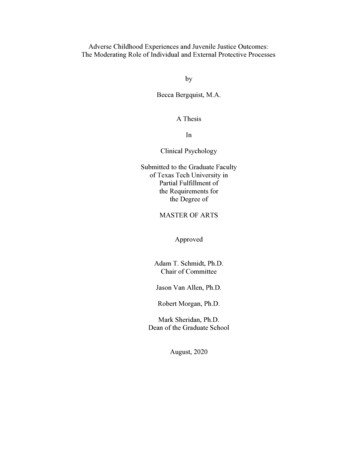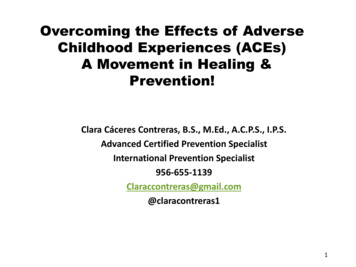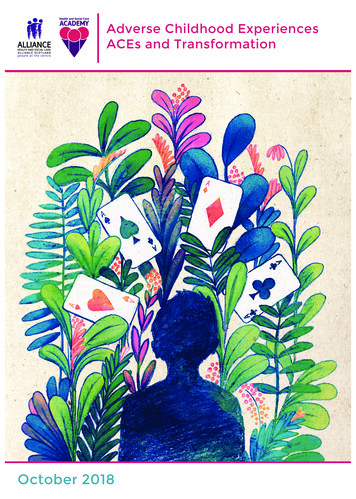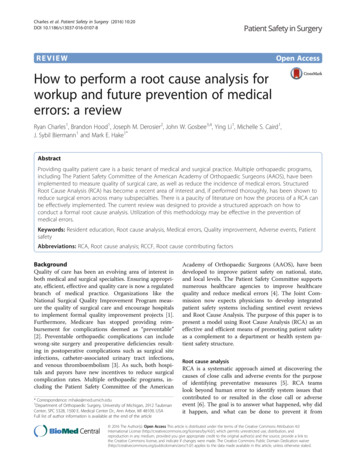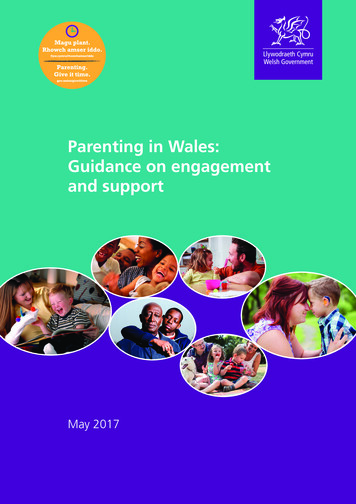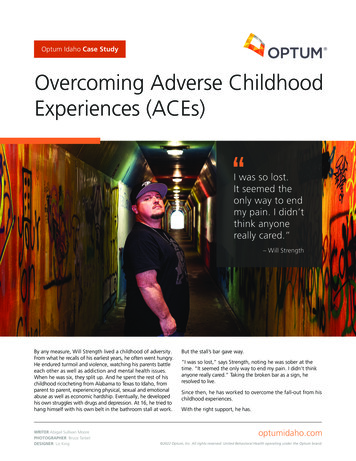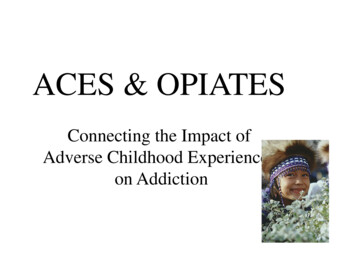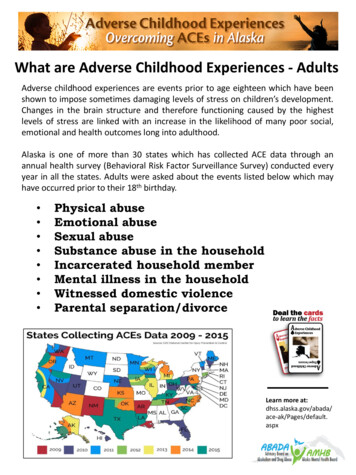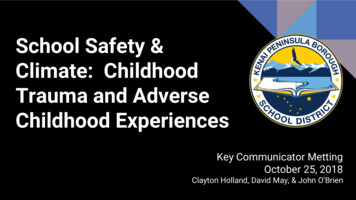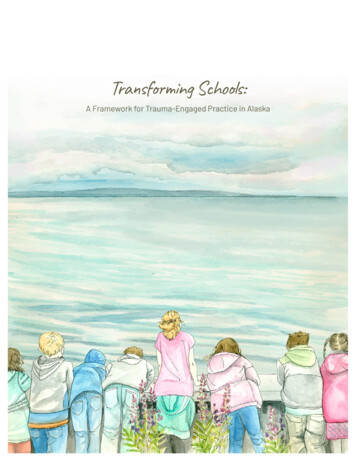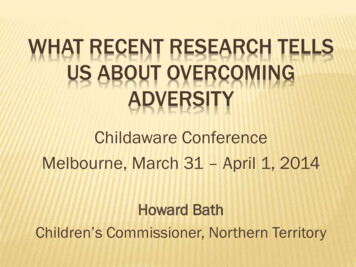
Transcription
Wednesday, October 20, 20218:30 a.m. to 9:15 a.m.Tennessee Academy of Family Physicians72nd Annual Scientific AssemblyThe Park Vista Doubletree Hotel, Gatlinburg, TennesseeOctober 19-22, 2021“Overcoming Adverse Childhood Experiences (ACE’s)”ELLY RILEY, D.O.Presentation Objectives:1)Understand how brain architecture is established early in life and supports lifelong learning, behavior, andhealth.2)Describe the role of safe, caring relationships and “serve and return” interactions in shaping brain architecture.3)Understand the impact of toxic stress on neurodevelopment and biological functioning across the lifespan.4)Introduce the Adverse Childhood Experiences (ACE) research and related poor social, emotional and physicalhealth outcomes.5)Recognize the dynamic micro and macro approaches to building resilience in children and communities tosupport positive outcomes to benefit citizen’s shared prosperity.6)Identify innovative, evolving public health strategies to improve population health.
Overcoming AdverseChildhood ExperiencesElly Riley, DOAssistant Professor, Family MedicineWest Tennessee Healthcare / UT MedicineJackson, TN
Learning objectives Understand how brain architecture is established early in life andsupports lifelong learning, behavior, and health.Describe the role of safe, caring relationships and “serve and return”interactions in shaping brain architecture.Understand the impact of toxic stress on neurodevelopment andbiological functioning across the lifespan.Introduce the Adverse Childhood Experiences (ACE) research andrelated poor social, emotional and physical health outcomes.Recognize the dynamic micro and macro approaches to buildingresilience in children and communities to support positive outcomes tobenefit citizens’ shared prosperity.Identify innovative, evolving public health strategies to improvepopulation health.
Building Strong Brains TennesseeMissionWe work to change the culture of Tennessee so that thestate’s overarching philosophy, policies, programs andpractices for children, youth and young adults utilize thelatest brain science to prevent and mitigate the impact ofadverse childhood experiences.
Successful Parenting of Next tyResponsibleCitizenshipLifelongHealthHealthy Child Development
Four Core Concepts of Development1Brain Architecture is established early in life andsupports lifelong learning, behavior and health.2Stable, caring relationships and “Serve and Return”interactions shape brain architecture.3Toxic Stress in the early years of life can derail healthydevelopment.4Resilience can be built through “Serve and Return”relationships, improving self-regulation skills and executivefunction. Though there are sensitive periods of braindevelopment in early childhood and adolescence,resilience can be strengthened at any age.
Brain ArchitectureBuilding Strong Foundations
Brain ArchitectureThe early years of life matter because early experiences affect thearchitecture of the maturing brain. As it emerges, the quality of thatarchitecture establishes either a sturdy or a fragile foundation for all of thedevelopment and behavior that follows. Getting things right the first timeis easier than trying to fix them later.
ONE MILLIONMore ThanNew Neural Connections Per SecondSource: Center on the Developing Child at Harvard University, 2009
Neural Circuits are Wired in aBottom-Up Sequence
Serve & Return RelationshipsSupport Skill Learning
Serve & Return InteractionsBuild Brains and Skills Young children naturally seek interaction through babbling,facial expressions and gestures, and adults respond in kind. These “serve and return" interactions are essential for thedevelopment of healthy brain circuits. Therefore, systems that support the quality of relationships inearly care settings, communities and homes also support thedevelopment of sturdy brain architecture. Quality relationships continue to be vital in adolescence inorder to reinforce brain architecture and build resilience.
The Brain’s Ability to Change Decreases Over TimeDuring puberty andadolescence, there isanother window ofplasticitySource: National Scientific Council on the Developing Child, 2009
Adolescent Brain Development: A Period ofVulnerabilities and OpportunitiesThe brain starts to undergo a “remodeling” project inadolescence, making it an opportune time to build resilience. Air Traffic Control: Before and during puberty, a second period ofrapid neural growth occurs in the prefrontal cortex. “Use it or lose it”: The adolescent brain strengthens the neuralconnections that are used most often and prunes away those thataren’t used as frequently. Integration: The corpus callosum, which relays informationbetween different parts of the brain, also undergoes waves ofgrowth during adolescence, improving self-regulation.Sources: Siegel, 2015; Spinks, n.d.
Intergenerational Transmission of Early AdversityEarly AdversityParental Neglect/AbuseDysregulated StressResponseRisk for Addiction &Mental HealthProblemsTurn Away fromInfantTurn to HabitualBehaviors to ReduceStressImpaired Responseto Infant Cues (HighStress/Low Reward)Parenting RelatedStress
Toxic StressDisrupts Brain Development
Body’s Response to Different Typesof Stress
Experience Alters Brain DevelopmentHealthy vs. Neglected BrainSources: Felitti, 2011; Nelson et al., 2007
Common Sources of Toxic StressU.S. Children Ages 2-5(per 1,000)13013675MaltreatmentPostpartum DepressionParental Substance AbuseSource: Center on the Developing Child at Harvard University, 2007
Toxic Stress Changes Gene ExpressionEpigeneticsIntergenerationalTransmission of StressResponse in Male Mice
How Brains are Builthttps://www.youtube.com/watch?v LmVWOe1ky8s
Adverse Childhood Experiences
Adverse Childhood ExperiencesSources: Center for Youth Wellness, n.d.; Centers for Disease Control and Prevention, 2016
ACE Study DemographicsParticipants were mostly white, middle-aged, college educatedand insured. They didn’t face many of life’s challenges such aspoverty or racism.11.2%4.6%7.2%24.8%15.1%1.9%75.2%At least some collegeNo college74.8%WhiteHispanicBlackAsianOther84.9%Ages 40 Ages 19-39Source: Centers for Disease Control and Prevention, 2016
ACEs Can Have Lasting Effects On Source: Centers for Disease Control and Prevention, 2016
Mechanisms by Which Adverse Childhood ExperiencesInfluence Health and Well-being Throughout the LifespanSource: Anda, n.d.
ACEs Compromise Community Prosperity*based on an ACE score of 4 Source: ACE Response, n.d.
Number of ACEs Experienced Before Age 18by Adult Tennesseans201761% had at least 1 ACE38.8%28% had 3 or more ACEs(that’s 1 in 4)20.5%20.0%12.9%7.8%01234 Source: Tennessee Department of Health, 2017
Share of Health Outcomes and Behaviors Attributedto Tennesseans Adverse Childhood %Source: Sycamore Institute, 2019
The Annual Economic Impact of Adverse ChildhoodExperiences in Tennessee is 5.2 BillionSource: Sycamore Institute, 2019
Resilience
Fostering Resiliencehttps://vimeo.com/106322359
Assure Every Child’s Relationships andEnvironments Are:
Positive Childhood Experiences (PCEs) BufferACEs and Promote Adult HealthSource: Bethell et. al,, 2019
Improving Air Traffic Control Helps withStress Management Across the LifespanFocusing AttentionProblem SolvingPlanning AheadBehavior RegulationControlling ImpulsesAdjusting to New CircumstancesExecutive Function and Self Regulation Skills can bebuilt at any point across the lifespan.Source: Cameron, n.d.
ACEs Require Public Health ApproachesRaise AwarenessPrimary PreventionPolicy ChangeCreating safe, stable, nurturingrelationships and environmentsas well as communityinfrastructures that promotesocial cohesionNorms ChangeSecondary PreventionServices for those “at risk”Tertiary PreventionTreatment Services
Move the Needle by Investing EarlyFocus has to shift from remediation to prevention and not just“prevention,” but primary preventionAge0I3I6I12I20Source: Perry, 2004
Build Executive Functioning inChildhood and Adolescence Sports andPhysical Activity Goal Setting,Planning andMonitoring Yoga, Meditationand MindfulnessActivities Journaling andSelf-Talk Logic Puzzlesand ComputerGames Theater, Musicand DanceSource: Center on the Developing Child at Harvard University, 2014
What CAN Be Done About ACEsAcross the Lifespan?Adopt Trauma-Informed SchoolPolicies and PracticesAccess to High-Quality,Affordable Childcare and Pre-KHome Visiting to PregnantWomen and Families withNewbornsBusiness and OrganizationPolicies that support workingparentsAccess to Integrated HealthcareParent Support Programs forTeens and Teen PregnancyPrevention Programs
What CAN Be Done About ACEsAcross the Lifespan?Access to Mental Health andSubstance Abuse TreatmentSufficient Income Support forLow-Income FamiliesIntimate Partner ViolencePreventionBringing CommunityDevelopment and ChildhoodDevelopment togetherHealth System Investment inCommunitiesSocial Supports for Parents and so much more
Prevention, Mitigation and Treatment of Adverse Childhood ExperiencesAnticipated Multi-Sector, Multi-Level Public and Private ImpactsBusinessesandCorporationsJuvenile andAdult JusticeProfessionalPracticeChild WelfareHealth CareServices andFinancingPrograms andServicesHumanServicesPolicies andFundingPhilanthropyPhilosophy andApproachMental Health &Substance AbuseServicesMediaFaith BasedCommunitiesEducation andEarly Care
The New Norm: Shifting theConversation What is wrong with you?TOWhat has happened to you?
Further InformationTennessee Commission on Children and Youth Websitehttps://www.tn.gov/tccy/topic/tccy-aces
To shorten this presentation, thefollowing videos were removed butwill be helpful to learn moreACES PrimerExperiences build brain architecture https://www.youtube.com/watch?v ccKFkcfXx-cServe and return interaction shapesbrain circuitry https://www.youtube.com/watch?v gmalxBM0ffMhttps://www.youtube.com/watch?v rVwFkcOZHJw/Serve and return interaction shapesbrain circuitry https://www.youtube.com/watch?v m 5u8-QSh6A/Toxic stress derails healthydevelopmentExperiences build brain architecture https://www.youtube.com/watch?v rVwFkcOZHJw/https://www.youtube.com/watch?v VNNsN9IJkws&t 31s
Adverse Childhood ExperiencesCommunity Surveyhttp://bit.ly/2dZOeWg
4) Introduce the Adverse Childhood Experiences (ACE) research and related poor social, emotional and physical health outcomes. 5) Recognize the dynamic micro and macro approaches to building resilience in children and communities to support positive outcomes to benefit citizen's shared prosperity.
